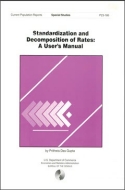
An official website of the United States government
Here’s how you know
Official websites use .gov
A .gov website belongs to an official government organization in the United States.
Secure .gov websites use HTTPS
A lock (
) or https:// means you’ve safely connected to the .gov website. Share sensitive information only on official, secure websites.
-
//
- Census.gov /
- Library /
- Publications /
- Standardization and Decomposition of Rates: A User's Manual
Standardization and Decomposition of Rates: A User's Manual
Standardization and Decomposition of Rates: A User's Manual
Overview
Designed to impart a working knowledge of the application of the techniques of "standardization and decomposition" and interpretation of results without getting the reader lost in the technical mathematical derivations. The techniques are illustrated by numerous examples from current journals, and extensive computer programs in FORTRAN language are provided for routine applications. Demographers and other social scientists have traditionally used the technique of direct standardization to eliminate the compositional effects (of age and sex, for example) from the overall rates (say, crude death rates) in two or more populations.
Decomposition, on the other hand, deals with finding the additive contributions of the differences in the compositional or rate factors (say, age, sex, and age-sex-specific death rates) in two populations to the difference in their overall rates (crude death rates, for example). The subjects of standardization and decomposition are strictly linked and, logically, one cannot be treated independently of the other.
The report provides methodologies for handling this dual problem of standardization and decomposition corresponding to any number of factors as well as any number of populations, for a variety of relationships of the factors with the overall rate (for example, the rate as the product of several factors) including the rate from cross-elassified data.
The problem of decomposition is different from the problem of regression analysis. For example, it is very likely that, in a regression analysis, a person's poverty status would be explained significantly by race, but that the difference in the race composition in two years would not be an important factor in explaining the difference in the poverty rates in those years.
Again, the method of decomposition in the report decomposes the difference between two rates into additive main effects and does not involve any interaction effects. This should be a desirable aspect in a decomposition problem because it lends itself to easier and simpler interpretations of the results.
A Note on Language
Census statistics date back to 1790 and reflect the growth and change of the United States. Past census reports contain some terms that today’s readers may consider obsolete and inappropriate. As part of our goal to be open and transparent with the public, we are improving access to all Census Bureau original publications and statistics, which serve as a guide to the nation's history.
Others in Series
Publication
Publication
Publication
Share
Some content on this site is available in several different electronic formats. Some of the files may require a plug-in or additional software to view.
 Yes
Yes
 No
NoComments or suggestions?


Top

